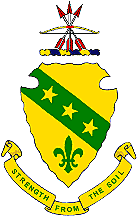According to Whitney Smith's Flag Book of the United States (1975), in the 1950s the North Dakota National Guard became concerned that it was inappropriate for the state to continue using a state flag based on a military regimental color, that carried by the North Dakota infantry in the Spanish-American War. They approached the Heraldic Services Division of the Army's Office of the Quartermaster General (now the Institute of Heraldry) to design a new state emblem that could be used for a new flag. In response, the acting Quartermaster General wrote to Major General Heber Edwards, the North Dakota Adjutant General, on January 30, 1957, as follows (quoting from the copy of the letter in the TIOH files):
In reference to your visit ... enclosed is a suggested design of a device for the State of North Dakota. The blazonry and description are as follows:DEVICE: On an Indian arrowhead point to base or a bend vert charged with three mullets of the first, in base a fleur-de-lis of the second.
CREST: On a wreath or and azure, a sheaf of three arrows argent armed and flighted gules behind a stringed bow fessways or with grip of the second (gules).
MOTTO: Strength From The Soil.
The colors yellow and green are indicative of the great agricultural state with particular reference to wheat, the principal grain, and the abundant grazing area. The Indian arrowhead symbolizes the "Sioux State". The three stars denote the three branches of the state government: executive, legislative, and judicial. They also allude to the history of the territory under three flags. Stars are borne upon the coat of arms of Meriwether Lewis* of the Lewis and Clark expedition and Lord Selkirk, head of the first permanent colony. The fleur-de-lis represents the French influence and the history of the territory as part of the Louisiana Purchase.
(signed)
ALFRED B. DENNISTON
Major General, USA
Acting The Quartermaster General


